You are using an out of date browser. It may not display this or other websites correctly.
You should upgrade or use an alternative browser.
You should upgrade or use an alternative browser.
Internal Body Aerodynamics
- Thread starter vette427sbc
- Start date
phantomjock
Well-known member
Pre 78 C-3? Buy VGs!
I have been spending some time pouring over engineering journals and papers trying to "smarten-up" on underbody and whole body aero.
Here is some information that may be of interest to the C3 (pre-78) owners. While these models are not Corvettes, the lessons ought to be reasonably transferable. A couple of grad students wrote a paper documenting their testing of a model, then modeled it in SolidWorks. They then compared their CFD results to the 'tunnel test. Satisfied the comparison was accurate enough, they then made several variations and ran CFD studies on each seeking to reduce drag and lift.
[NOTE: They were not "chasing" downforce, just Lift.]
I've "lifted" their summary table and pics of each case and the summary graphs comparing the reductions of Drag and Lift.
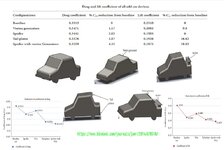
You'll note the greatest single improvement was Vortex Generators on the trailing edge of the roof.
Hint-Hint to member 69427! The best approach was VGs in conjunction with a wing mounted -- although they referred to it as a "spoiler" in their report, they modeled a wing.
I'm not making any promises, but have on my plate of things to do; to trial a comparison in SW with a C3 pre-78. If/when it gets done - I'll share here.
Cheers - Jim
I have been spending some time pouring over engineering journals and papers trying to "smarten-up" on underbody and whole body aero.
Here is some information that may be of interest to the C3 (pre-78) owners. While these models are not Corvettes, the lessons ought to be reasonably transferable. A couple of grad students wrote a paper documenting their testing of a model, then modeled it in SolidWorks. They then compared their CFD results to the 'tunnel test. Satisfied the comparison was accurate enough, they then made several variations and ran CFD studies on each seeking to reduce drag and lift.
[NOTE: They were not "chasing" downforce, just Lift.]
I've "lifted" their summary table and pics of each case and the summary graphs comparing the reductions of Drag and Lift.

You'll note the greatest single improvement was Vortex Generators on the trailing edge of the roof.
Hint-Hint to member 69427! The best approach was VGs in conjunction with a wing mounted -- although they referred to it as a "spoiler" in their report, they modeled a wing.
I'm not making any promises, but have on my plate of things to do; to trial a comparison in SW with a C3 pre-78. If/when it gets done - I'll share here.
Cheers - Jim
I see the illustrations of a duct feeding air through a radiator. Stupid question: Do race cars use electric fans?
phantomjock
Well-known member
Mine does. The left-handers do. Dragsters, even Formula 1, but they keep getting smaller radiators to cut the internal drag.I see the illustrations of a duct feeding air through a radiator. Stupid question: Do race cars use electric fans?
Post-Chaparral fan-car days, The Spec Mazda class does - but they are the OEM radiator fans. I believe tech looks close at the size and perceived downforce contribution. I've never had any questions as I'm in an "open" class.
Cheers - Jim
phantomjock
Well-known member
I see a couple using the VGs in combo with the upper "tail plate" too. I was quite surprised at the baseline Cd as well - would have thought closer to 0.4 being a "box." There are quite a few options available on eBay, so suppose that might be their go-to source, as the prices are pretty reasonable. Some are as low as under 30 bucks. Easy to install and cheap enuf to do some C3 testing.
HINT - Hint! :stirpot:
Cheers - Jim
HINT - Hint! :stirpot:
Cheers - Jim
Mine does. The left-handers do. Dragsters, even Formula 1, but they keep getting smaller radiators to cut the internal drag.I see the illustrations of a duct feeding air through a radiator. Stupid question: Do race cars use electric fans?
Post-Chaparral fan-car days, The Spec Mazda class does - but they are the OEM radiator fans. I believe tech looks close at the size and perceived downforce contribution. I've never had any questions as I'm in an "open" class.
Cheers - Jim
Seems like the ducting, or at least inlet area, for a fan cooled radiator would be dramatically different?
mfain
Well-known member
Mine does. The left-handers do. Dragsters, even Formula 1, but they keep getting smaller radiators to cut the internal drag.I see the illustrations of a duct feeding air through a radiator. Stupid question: Do race cars use electric fans?
Post-Chaparral fan-car days, The Spec Mazda class does - but they are the OEM radiator fans. I believe tech looks close at the size and perceived downforce contribution. I've never had any questions as I'm in an "open" class.
Cheers - Jim
Seems like the ducting, or at least inlet area, for a fan cooled radiator would be dramatically different?
You also need to account for the velocity of the inlet air. Here is an inlet diffuser I helped design and my son built for a 300 mph Bonneville Salt Flat car. We were able to shrink the inlet down even smaller (2 inches vertical) to get 22% of the radiator surface area. This reduced drag and did not effect the cooling.
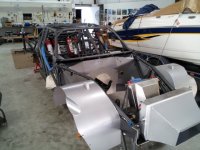
phantomjock
Well-known member
Pappy - Good work on that design. Did the car (and your son) get to the 300mph?
I've been doing a bit of follow-up on ducting etc especially focused on the radiator duct. Interestingly enough, Walter Korff said in 1988, that the inlet could be 1/6 of the radiator surface area, "for fast moving vehicles such as racers and aircraft."
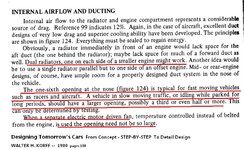
That section goes with the duct design image a few posts back.
Interesting that he was also quoting a wind tunnel test where they blocked off the radiator grill on a Chevette and a Corvette. They found the Chevette showed 7-8% Higher drag with the radiator open. The Corvette was 6.5% higher with the radiator OPEN.
Note his comments regarding the use of electric fans. An additional benefit of ducting is the obvious removal (isolating) the radiator heat from the engine bay. With some appropriate coatings/wraps on the exhaust headers, heat could be further reduced.
The obvious issue then comes how to cool the engine if the intake is covered or closed all the time?
In a old PS article, there was this interesting approach by Ford on the Capri:
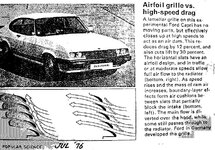
Speaking of heat, in a NACA 1939 article (translation from German) on radiator ducting, there was considerable concern regarding an increase in drag (resistance) as the radiator heated.
emphasis mine...
I think with smart technology, the grillwork could be adjusted using the initial settings Ford found and implemented on the Capri. Anyone have access to an old German-built Capri? Or was this also on US models?
Cheers - Jim
I've been doing a bit of follow-up on ducting etc especially focused on the radiator duct. Interestingly enough, Walter Korff said in 1988, that the inlet could be 1/6 of the radiator surface area, "for fast moving vehicles such as racers and aircraft."

That section goes with the duct design image a few posts back.
Interesting that he was also quoting a wind tunnel test where they blocked off the radiator grill on a Chevette and a Corvette. They found the Chevette showed 7-8% Higher drag with the radiator open. The Corvette was 6.5% higher with the radiator OPEN.
Note his comments regarding the use of electric fans. An additional benefit of ducting is the obvious removal (isolating) the radiator heat from the engine bay. With some appropriate coatings/wraps on the exhaust headers, heat could be further reduced.
The obvious issue then comes how to cool the engine if the intake is covered or closed all the time?
In a old PS article, there was this interesting approach by Ford on the Capri:

Speaking of heat, in a NACA 1939 article (translation from German) on radiator ducting, there was considerable concern regarding an increase in drag (resistance) as the radiator heated.
At small axial-flow coefficients, i.e., in the high-speed flight,range, the built-in radiator discloses high additional resistances which, in general , amount to a multiple of the inside cooling drag and of the frictional drag on the radiator ducts.
emphasis mine...
I think with smart technology, the grillwork could be adjusted using the initial settings Ford found and implemented on the Capri. Anyone have access to an old German-built Capri? Or was this also on US models?
Cheers - Jim
mfain
Well-known member
Jim,
The Daytona Charger has run in low 280s so far - still sorting it. My son is the sole fabricator, but not the owner-driver. This Camaro is being built in Plano TX. Thought you might find it interesting. I think the angle of the air departing the "chimneys" needs to be studied with respect to airflow over the doghouse and its effect on drag and downforce. Too much vertical component of the airflow may not be the best answer - and of course it will be a dynamic solution based on speed of the vehicle.
Pappy


Edit: Wonder where what appears to be two round vents in the firewall behind the tire go?
The Daytona Charger has run in low 280s so far - still sorting it. My son is the sole fabricator, but not the owner-driver. This Camaro is being built in Plano TX. Thought you might find it interesting. I think the angle of the air departing the "chimneys" needs to be studied with respect to airflow over the doghouse and its effect on drag and downforce. Too much vertical component of the airflow may not be the best answer - and of course it will be a dynamic solution based on speed of the vehicle.
Pappy


Edit: Wonder where what appears to be two round vents in the firewall behind the tire go?
Last edited:
69427
The Artist formerly known as Turbo84
- Joined
- Mar 30, 2008
- Messages
- 3,077
- Reaction score
- 38
In Jim's post above, I've always liked the idea of dual radiators on the sides of the engine. My personal reason is that I like the idea of moving the radiator (and coolant) weight rearward, instead of its normal position ahead of the front axle line (which degrades the c/g location and increases the vehicle's MoI).
As our C3s are usually left side heavy, I've been contemplating putting a motorcycle type/size radiator in the righthand fender louver cavity, and then reducing the size of the main radiator. This would slightly move the c/g to the right and rearward.
(I've looked a few times at determining the obstacles of putting the radiator in the rear, but packaging issues (due to the rear mufflers) and airflow sourcing has put that project on hold for a while yet.)
As our C3s are usually left side heavy, I've been contemplating putting a motorcycle type/size radiator in the righthand fender louver cavity, and then reducing the size of the main radiator. This would slightly move the c/g to the right and rearward.
(I've looked a few times at determining the obstacles of putting the radiator in the rear, but packaging issues (due to the rear mufflers) and airflow sourcing has put that project on hold for a while yet.)
phantomjock
Well-known member
Plano TX - Is that where RaceCraft is (chassis builders)?
Yeah - what are those 2 "ports" for? Certainly not cockpit!
- Left side heavy - is that due to a (my) lard A55? :evil:
I came to see Jeff Hawkins solution - long after I built my set up:

Here is the body off:
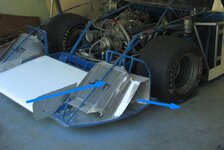
The smaller well placed radiators are a great idea.
He took the car to A-2 wind tunnel and has the data to prove it could race on the ceiling. Has set new track records at every outing as I recall. The first one he beat by over 2 seconds - in his first outing.
We had a good long chat (a few years back), and he is a believer in VGs, uses a bunch in the "unseen" tunnels.
I have (unfortunately?) filled the side pods/louvers with oil coolers for engine and transmission. Seemed like a good idea at the time!
Cheers - Jim
Yeah - what are those 2 "ports" for? Certainly not cockpit!
- Left side heavy - is that due to a (my) lard A55? :evil:
I came to see Jeff Hawkins solution - long after I built my set up:

Here is the body off:

The smaller well placed radiators are a great idea.
He took the car to A-2 wind tunnel and has the data to prove it could race on the ceiling. Has set new track records at every outing as I recall. The first one he beat by over 2 seconds - in his first outing.
We had a good long chat (a few years back), and he is a believer in VGs, uses a bunch in the "unseen" tunnels.
I have (unfortunately?) filled the side pods/louvers with oil coolers for engine and transmission. Seemed like a good idea at the time!
Cheers - Jim
69427
The Artist formerly known as Turbo84
- Joined
- Mar 30, 2008
- Messages
- 3,077
- Reaction score
- 38
- Left side heavy - is that due to a (my) lard A55? :evil:
......................................................!
Cheers - Jim
I don't have four wheel scales to confirm my belief, but just a quick observation of our cars seem to indicate it.
The left side of the car holds the battery, driver, steering column, pedals, p/b booster and m/c, steering box, p/s pump, and alternator.
The right side of the car holds the jack, heater core, (a/c evaporator and compressor if optioned), and about 3% (15-20#) of extra engine weight due to the one inch offset.
I've moved as much stuff away from the left side as I can, but my car still feels like it goes around LH corners quicker than RH corners.
phantomjock
Well-known member
ACTIVE AERO - BIG TIME! [Not Cheap]
Make your C3 as relevant as the upcoming C8?! Maybe - but it'll cost ya.
(If you buy it outright- but hey -- we can "engineer"- right?)
An outfit known as AMS performance has been marketing an active rear wing for several years.
If you want to link to the setup:
https://aeromotions.com/products/chevrolet/s1-dynamic-chevrolet-corvette-c6-wing/
- or this summary:

Here is a video of the system in action: (warning- it is an external camera--turn down the volume!)
[ame]https://www.youtube.com/watch?v=hKb5Vcn_3Yw&t=2s[/ame]
Some of the specifics on the wing: (Note-the wing is split in the center and each half moves independently.
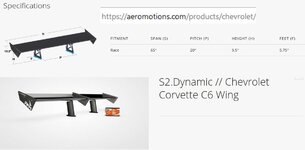
The earlier implementation used a cockpit controller, but it appears that the newer versions are "smart enough" to not require using that (seems to be/but not verified). Not cheap, but could be "reverse engineered" with someone that has a good working knowledge of Arduino mini-computer setups. With the right number of IMUs/gyro inputs the Arduino could do all the cornering/braking/drag reduction automatically, and use the onboard IMU/GPS/etc to do its own feedback.
Long live JIM HALL!
Cheers - Jim
Make your C3 as relevant as the upcoming C8?! Maybe - but it'll cost ya.
(If you buy it outright- but hey -- we can "engineer"- right?)
An outfit known as AMS performance has been marketing an active rear wing for several years.
If you want to link to the setup:
https://aeromotions.com/products/chevrolet/s1-dynamic-chevrolet-corvette-c6-wing/
- or this summary:

Here is a video of the system in action: (warning- it is an external camera--turn down the volume!)
[ame]https://www.youtube.com/watch?v=hKb5Vcn_3Yw&t=2s[/ame]
Some of the specifics on the wing: (Note-the wing is split in the center and each half moves independently.

The earlier implementation used a cockpit controller, but it appears that the newer versions are "smart enough" to not require using that (seems to be/but not verified). Not cheap, but could be "reverse engineered" with someone that has a good working knowledge of Arduino mini-computer setups. With the right number of IMUs/gyro inputs the Arduino could do all the cornering/braking/drag reduction automatically, and use the onboard IMU/GPS/etc to do its own feedback.
Long live JIM HALL!
Cheers - Jim
Latest posts
-
-
-
-
-
-
-
-
Was member years ago dropping by to say hello.
- Latest: crazyhorse
-
-
-
-
-
